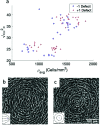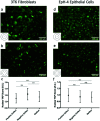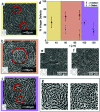Topological defects of integer charge in cell monolayers
- PMID: 33710239
- PMCID: PMC8220479
- DOI: 10.1039/d1sm00100k
Topological defects of integer charge in cell monolayers
Abstract
Many cell types spontaneously order like nematic liquid crystals, and, as such, they form topological defects, which influence the cell organization. While defects with topological charge ±1/2 are common in cell monolayers, defects with charge ±1, which are thought to be relevant in the formation of protrusions in living systems, are more elusive. We use topographical patterns to impose topological charge of ±1 in controlled locations in cell monolayers. We study two types of cells, 3T6 fibroblasts and EpH-4 epithelial cells, and we compare their behavior on such patterns, characterizing the degree of alignment, the cell density near the defects, and their behavior at the defect core. We observe density variation in the 3T6 monolayers near both types of defects over the same length-scale. By choosing appropriate geometrical parameters of our topographical features, we identify a new behavior of 3T6 cells near the defects with topological charge +1, leading to a change in the cells' preferred shape. Our strategy allows a fine control of cell alignment near defects as a platform to study liquid crystalline properties of cells.
Conflict of interest statement
There are no conflicts to declare.
Figures






Similar articles
-
Integer topological defects of cell monolayers: Mechanics and flows.Phys Rev E. 2021 Jan;103(1-1):012405. doi: 10.1103/PhysRevE.103.012405. Phys Rev E. 2021. PMID: 33601623
-
Topological defects in epithelia govern cell death and extrusion.Nature. 2017 Apr 12;544(7649):212-216. doi: 10.1038/nature21718. Nature. 2017. PMID: 28406198 Free PMC article.
-
Quantifying Material Properties of Cell Monolayers by Analyzing Integer Topological Defects.Phys Rev Lett. 2021 Jan 15;126(2):028101. doi: 10.1103/PhysRevLett.126.028101. Phys Rev Lett. 2021. PMID: 33512187
-
Spontaneous flow created by active topological defects.Eur Phys J E Soft Matter. 2022 Apr 7;45(4):30. doi: 10.1140/epje/s10189-022-00186-2. Eur Phys J E Soft Matter. 2022. PMID: 35389081 Review.
-
Biological Tissues as Active Nematic Liquid Crystals.Adv Mater. 2018 Nov;30(47):e1802579. doi: 10.1002/adma.201802579. Epub 2018 Aug 29. Adv Mater. 2018. PMID: 30156334 Review.
Cited by
-
Migration and division in cell monolayers on substrates with topological defects.Proc Natl Acad Sci U S A. 2023 Jul 25;120(30):e2301197120. doi: 10.1073/pnas.2301197120. Epub 2023 Jul 18. Proc Natl Acad Sci U S A. 2023. PMID: 37463218 Free PMC article.
-
Molecular-scale substrate anisotropy, crowding and division drive collective behaviours in cell monolayers.J R Soc Interface. 2023 Jul;20(204):20230160. doi: 10.1098/rsif.2023.0160. Epub 2023 Jul 5. J R Soc Interface. 2023. PMID: 37403487 Free PMC article.
-
Integer topological defects offer a methodology to quantify and classify active cell monolayers.Nat Commun. 2025 Mar 12;16(1):2452. doi: 10.1038/s41467-025-57783-w. Nat Commun. 2025. PMID: 40069207 Free PMC article.
-
Machine learning topological defects in confluent tissues.Biophys Rep (N Y). 2024 Jan 9;4(1):100142. doi: 10.1016/j.bpr.2024.100142. eCollection 2024 Mar 13. Biophys Rep (N Y). 2024. PMID: 38313863 Free PMC article.
-
Appreciating the role of cell shape changes in the mechanobiology of epithelial tissues.Biophys Rev (Melville). 2022 Mar 16;3(1):011305. doi: 10.1063/5.0074317. eCollection 2022 Mar. Biophys Rev (Melville). 2022. PMID: 38505223 Free PMC article. Review.
References
-
- Bouligand Y. C. R. Chim. 2008;11:281–296. doi: 10.1016/j.crci.2007.10.001. - DOI
MeSH terms
Grants and funding
LinkOut - more resources
Full Text Sources
Other Literature Sources
Miscellaneous

